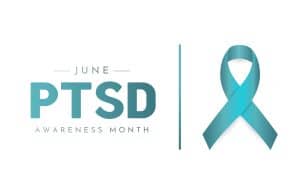This blog post is brought to you by Jana B., Eckstrom-Columbus Library
Everything is calm and quiet.
All the people here are relaxed and going about their business. Except me. I’m feeling light-headed and my stomach is doing flip-flops like I’m on a roller coaster. There’s a buzzing in my ears and my palms are sweaty. Why? Because something triggered a PTSD flashback.
This is a common refrain of people who suffer from PTSD.
The body has no sense of past, present, or future. Anything happening in the body is happening right now, so even though the original event may be in the past, the response is not. As Dr. Bessel A. van der Kolk states in The Body Keeps the Score: Brain, Mind, and Body in the Healing of Trauma, “…trauma is much more than a story about something that happened long ago. The emotions and physical sensations that were imprinted during the trauma are experienced not as memories but as disruptive physical reactions in the present.” Dr. van der Kolk goes on to say, “Being traumatized means continuing to organize your life as if the trauma were still going on—unchanged and immutable—as every new encounter or event is contaminated by the past.” This is how triggers work. While non-triggered individuals may think the weather is hot, the triggered person may be feeling the cold weather from the original trauma.
So what causes PTSD?
The truth is that it can be just about anything. The diagnosis was developed to describe what was happening to combat veterans, but research [1] has since indicated that a wide range of experiences can cause Post Traumatic Stress. In the words of Dr. Peter Levine, “Trauma is not what happens to us, but what we hold inside in the absence of an empathetic witness… What I do know is that we become traumatized when our ability to respond to a perceived threat is in some way overwhelmed. This inability to adequately respond can impact us in obvious ways, as well as subtle ways.” Any event that causes stress beyond our ability to cope can cause PTSD. Very few US citizens were in New York or Washington D.C. on September 11, 2001, and yet people across the nation felt the impact. Reports of violence on the news can trigger me because I often feel helpless, and I know I’m not the only one.
There are so many different ways PTSD can manifest.
The symptoms tend to fall into four basic categories. First, intrusive memories. Dr. Levine states “The symptoms of trauma can be stable, that is, ever-present. They can also be unstable, meaning that they can come and go and be triggered by stress. Or they can remain hidden for decades and suddenly surface. Usually, symptoms do not occur individually but come in groups. They often grow increasingly complex over time, becoming less and less connected with the original trauma experience.” This is commonly termed flashbacks. The flashback response is described above as being when the body or psyche is responding to a past event as though it were happening in the present. Sometimes this will include a sensory experience of the past (i.e. you can hear the sounds that happened even though they aren’t there at the moment) or it can be the emotions of the past trauma without any physical input.
The next category is avoidance. This can be as simple as changing the way you go home from work to avoid the spot where you got in an accident. It can be as complicated as avoiding anywhere a person went with their spouse in 40 years of marriage. All people avoid situations that cause distress. That’s why most people don’t touch hot stoves. It becomes a problem when one’s whole life is patterned around trying to avoid these triggers. In her book Healing the Fragmented Selves of Trauma Survivors: Overcoming Internal Self-Alienation, Jenina Fisher said “Curiously enough, if we primarily try to shield ourselves from discomfort, we suffer. Yet when we don’t close off and we let our hearts break, we discover our kinship with all beings.”
The third category is physical and emotional changes. As stated by Dr. van der Kolk, “After trauma the world is experienced with a different nervous system. The survivor’s energy now becomes focused on suppressing inner chaos, at the expense of spontaneous involvement in their lives. These attempts to maintain control over unbearable physiological reactions can result in a whole range of physical symptoms, including fibromyalgia, chronic fatigue, and other autoimmune diseases. This explains why it is critical for trauma treatment to engage the entire organism, body, mind, and brain.” This can also include major changes in behavior. “If we look at this man’s behaviors without knowing anything about his past, we might think he was mad. However, with a little history, we can see that his actions were a brilliant attempt to resolve a deep emotional scar. His re-enactment took him to the very edge, again and again, until he was finally able to free himself from the overwhelming nightmare of war. ACCIDENTS “JUST” HAPPEN” says Dr. Levine.
And the final category is hypervigilance. “In our studies, we keep seeing how difficult it is for traumatized people to feel completely relaxed and physically safe in their bodies... Rather than going into a state of quiet repose, our students’ muscles often continue to prepare them to fight unseen enemies. A major challenge in recovering from trauma remains being able to achieve a state of total relaxation and safe surrender,” said Bessel A. van der Kolk in describing his research. Judith Lewis Herman states in her book Trauma and Recovery: The Aftermath of Violence, From Domestic Abuse to Political Terror, “After a traumatic experience, the human system of self-preservation seems to go onto permanent alert, as if the danger might return at any moment.” This can lead to tension headaches, exhaustion, brain fog, and myriad other physical symptoms.
A proven method of dealing with feeling triggered is mindfulness.
Resmaa Menakem says in her book, My Grandmother’s Hands: Dealing with Racialized Trauma, “Recent studies and discoveries increasingly point out that we heal primarily in and through the body, not just through the rational brain. We can all create more room, and more opportunities for growth, in our nervous systems. But we do this primarily through what our bodies experience and do—not through what we think or realize or cognitively figure out.” There is research [2, 3] showing that embodiment practices such as mindfulness, dance, and yoga can help manage PTSD. Even simple breathing and grounding exercises can make a difference, according to Dr. Pete Walker in Complex PTSD: From Surviving to Thriving.
So how can loved ones help?
The Mayo Clinic has some great suggestions. Among them is listening to the person’s trauma story. This sometimes feels like a big ask because stories can be hard to hear. And yet, reclaiming one’s own story is a huge step in healing trauma. To revisit a quote from earlier in this blog “Trauma is not what happens to us, but what we hold inside in the absence of an empathetic witness.” There is power in being an empathetic witness. It seems logical to an outsider that the person undergoing the trauma did not deserve it or did not cause it, but such things are not always obvious to those with PTSD. In the words of Fred Rogers, “Anything that’s human is mentionable, and anything that is mentionable can be more manageable. When we can talk about our feelings, they become less overwhelming, less upsetting, and less scary. People we trust with that important talk can help us know that we are not alone.” While Fred Rogers may not be a certified therapist, his words agree with experts such as Dr. van der Kolk “Being able to feel safe with other people is probably the single most important aspect of mental health; safe connections are fundamental to meaningful and satisfying lives.”
It seems living through trauma is inevitable in the course of a human lifetime.
Many people have had to learn coping mechanisms to survive daily life. It’s uplifting to know that the bad things that happen to us do not need to define us. As Dr. Levine reminds us, “Trauma is hell on earth. Trauma resolved is a gift from the gods.” Trauma recovery is a long road. With time and practice, triggers become less frequent and less overwhelming when they do crop up. It gives me a great deal of hope to know that connection and mindfulness can bring peace and healing. Life is hard, but I think almost everybody can find themselves in the words of Winnie the Pooh “You’re braver than you believe, stronger than you seem, and smarter than you think.”
- https://www.mayoclinic.org/diseases-conditions/post-traumatic-stress-disorder/symptoms-causes/syc-20355967
- https://www.ncbi.nlm.nih.gov/pmc/articles/PMC6973294/
- https://europepmc.org/article/med/31348987
-
https://www.psychologytoday.com/us/blog/think-act-be/201903/the-healing-power-telling-your-trauma-story




